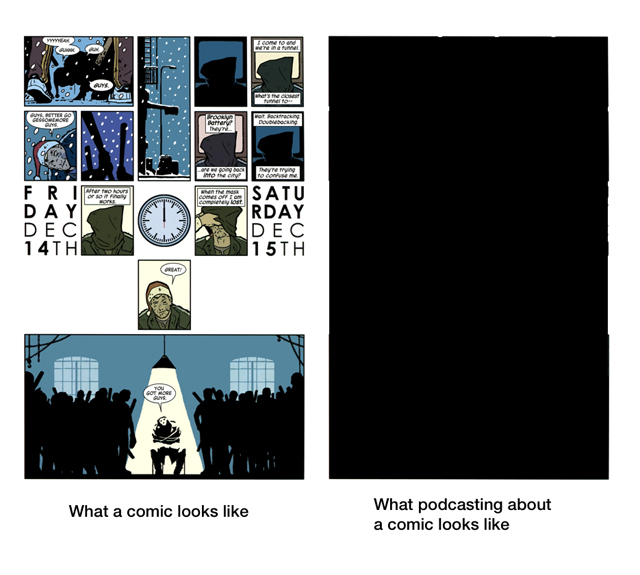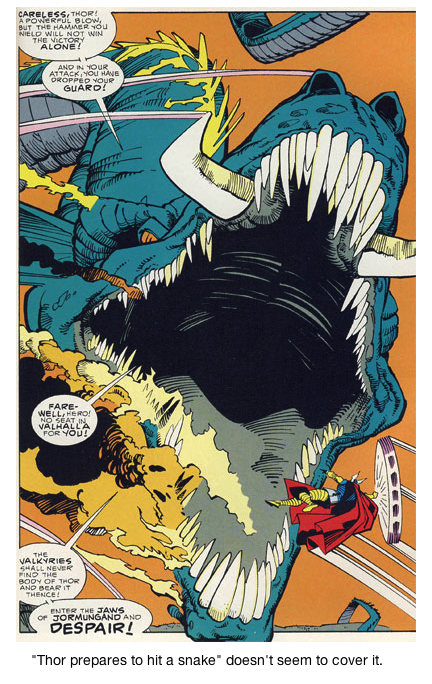
"A lot of comics journalism talks about the story -- in part because that's easy," says Graeme McMillian, who co-hosts Savage Critic's Wait, What?, along with Jeff Lester. Graeme and Jeff both met when hanging out at Comix Experience and writing for the shop's newsletter. After Graeme moved north to Portland, they continued podcasting weekly chatfests held over Skype (which, due to technical issues, almost because a character itself in their narrative) or FaceTime.
There certainly are some podcasts that recap plots only, the way Television Without Pity recaps TV shows: check out Tom Vs. Comics . Dylan Cassard, of the Comic Book of the Month podcast, says that his crew "spend a decent amount of time discussing story because that's easily conveyed." But they only spend about 10 minutes or so each episode on art, despite both Cassard and co-hosts being artists: "Sometimes the art goes beyond our vocabulary. We try and discuss line-weights, and scratchy versus rough, use of spotted blacks, and interesting color palettes, but at the end of the day, we have to hope they Google it and like what they see."
It's that difficulty, and the feeling that art is indeed more subjective, says McMillan, that makes him feel that talking about what the listeners can't see might be "off-putting." "It's the same reason you don't see many podcasts about fine art," he says. Still, the podcasters come and go, talking about, well, art. Sometimes the talk is like talking about bands, or making a Hollywood pitch -- "It's like Ghost meets Titanic" or "they sound like My Chemical Romance crossed with X" or "I can say that I never liked Richard Corben's art because it seemed like a brutish Vermeer but with putty for flesh." Or the talk can be through references to canonical artists: "For example, I can say 'Sal Buscema' as opposed to 'John Buscema'," says Lester, "and people who've read it know what it means. It gives the conversation a speed and facility, but can also constrain the conversation."
But there's a way to cut the Gordian knot. Audio may not be able to show line, color, or form, but it is good at conveying emotion, and the emotion art can evoke. David Brothers, who long had his own SF-based podcast with Esther Inglis-Arkell, and has been a guest on other comics podcasts, says that "an important part of building a vocabulary to talk about comics is being able to accurately describe the feeling of the art of the page. If you're talking about it, you should talk about how it feels to you in addition to what it is, rather than one or the other."

McMillan (who, it should be noted, has an advanced degree in, and has taught, art) also stressed how the emotional impact of art can be a good focus, one that can be conveyed non-visually. "Comics has a narrative element, but the art is sometimes the point in the actual creating and reading experience." He gives an example: "Thor is punching someone" is plot, but "Walter Simonson's Thor is punching someone" is an art experience. The value, he said, is being able to express how this experience makes one feel. Lester backed him up: "In a podcast, you can convey and hear the immediate passion about something in the voices."
And, I want to stress, an amazing amount of fun also comes across. These podcasts are often described by their hosts as an excuse to hang out and chat with friends; in the good podcasts, it's obvious, and infectious.
McMillan added, "If you only talk about the details [of the art], you can skip over the impact it has on you. Try describing Rothko."
It's funny he picked that example. One of my most visceral fine art experiences was at SFMOMA, and involved Rothko. Perhaps it was something about the grey, foggy day outside (so, yes, it was summer in SF), perhaps it was that I'd just been examining Michael Jackson and Bubbles by Jeff Koons' factory for too long. But I turned, and Rothko's No. 14 was there, framed by an open doorway. The dark blue, almost black, grounded me, where the red brought real warmth and life as though the sun was rising, not setting. It's framed perfectly by a passage into a new space; its height (almost 10 feet) is a critical part, keeping it large from a distance and giving the feeling that one is walking into it when approaching. I was taken from critical and cynical thinking (perhaps the reaction Koons wanted) to feeling the color radiate and calm me.



